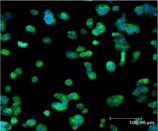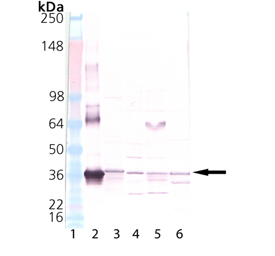Product Details
| Alternative Name: | HMOX2, Hsp32, Heat shock protein 32, Heme oxygenase 2 |
| |
| Host: | Rabbit |
| |
| Immunogen: | Synthetic peptide corresponding to the sequence near the N-terminus of human HO-2. |
| |
| UniProt ID: | P30519 |
| |
| GenBank ID: | S34389 |
| |
| Source: | Purified from rabbit serum. |
| |
| Species reactivity: | Human, Mouse, Rat
Dog, Hamster, Monkey, Porcine
|
| |
| Applications: | ELISA, ICC, IF, IHC, IP, WB
|
| |
| Recommended Dilutions/Conditions: | Immunohistochemistry (1:50)
Immunoprecipitation (10µg/ml, denatured)
Western Blot (1:1,000, colorimetric)
Suggested dilutions/conditions may not be available for all applications.
Optimal conditions must be determined individually for each application. |
| |
| Application Notes: | Detects a band of ~36kDa by Western blot. |
| |
| Purity Detail: | Protein A affinity purified. |
| |
| Formulation: | Liquid. In PBS containing 50% glycerol and 0.09% sodium azide. |
| |
| Handling: | Avoid freeze/thaw cycles. |
| |
| Shipping: | Blue Ice |
| |
| Long Term Storage: | -20°C |
| |
| Scientific Background: | Heme Oxygenase-1 (HO-1) also known as Hsp32, is the inducible isoform of heme oxygenase that catalyzes the NADPH, oxygen, and cytochrome P450 reductase dependent oxidation of heme to carbon monoxide, ferrous iron and biliverdin which is rapidly reduced to bilirubin. These products of the HO reaction have important physiological effects: carbon monoxide is a potent vasodilator and has been implicated to be a physiological regulator of cGMP and vascular tone; biliverdin and its product bilirubin are potent antioxidants; "free" iron increases oxidative stress and regulates the expression of many mRNAs (e.g., DCT-1, ferritin and transferring receptor) by affecting the conformation of iron regulatory protein (IRP)-1 and its binding to iron regulatory elements (IREs) in the 5'- or 3'- UTRs of the mRNAs. To date, three identified heme oxygenase isoforms are part of the HO system that catalyze heme into biliverdin and carbon monoxide. These are inducible HO-1 or Hsp32, constitutive HO-2 that is abundant in the brain and testis, and HO-3 which is related to HO-2 but is the product of a different gene. The HO system is the rate-limiting step in heme degradation and HO activity decreases the levels of heme which is a well known potent catalyst of lipid peroxidation and oxygen radical formation. |
| |
| Regulatory Status: | RUO - Research Use Only |
| |

Immunohistochemistry analysis of human breast cancer tissue with HO-2 pAb.

Immunofluorescent analysis (confocal) staining of MCF-7 cells using HO-2 pAb (green); nuclei are stained in blue pseudocolor using DRAQ5.

Western blot analysis of HO-2, pAb: Lane 1: MW marker, Lane 2: HO-2 Recombinant Human Protein (Prod. No. ADI-SPP-550), Lane 3: Human Liver Microsome Extract, Lane 4: Mouse Liver Microsome Extract, Lane 5: Rat Liver Microsome Extract, Lane 6: Dog Liver Microsome Extract.
Please mouse over
Product Literature References
Effects of hypoxia on heme oxygenase expression in human chorionic villi explants and immortalized trophoblast cells: G.E. Lash, et al. ; Am. J. Physiol. Heart Circ. Physiol.
284, H853 (2003),
Application(s): WB using human samples,
Abstract;
Endogenous heme oxygenase prevents impairment of cerebral vascular functions caused by seizures: H. Parfenova, et al. ; Am. J. Physiol. Heart Circ. Physiol.
285, H1148 (2003),
Application(s): WB using porcine samples,
Abstract;
Gene therapy strategy for long-term myocardial protection using adeno-associated virus-mediated delivery of heme oxygenase gene: V.J. Dzau, et al. ; Circulation
105, 602 (2002),
Application(s): WB using rat samples,
Abstract;
Carbon monoxide generated by heme oxygenase-1 suppresses the rejection of mouse-to-rat cardiac transplants: M.P. Soares, et al. ; J. Immunol.
166, 4185 (2001),
Application(s): WB using mouse samples,
Abstract;
Amyloid precursor proteins inhibit heme oxygenase activity and augment neurotoxicity in Alzheimer's disease: S.H. Snyder, et al. ; Neuron
28, 461 (2000),
Application(s): ICC using rat samples,
Abstract;
















